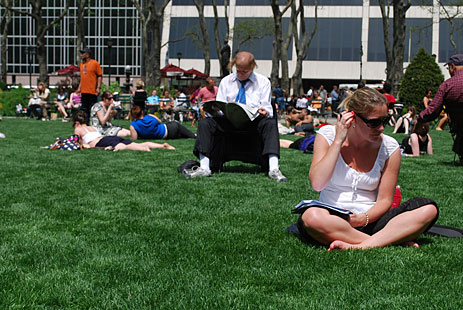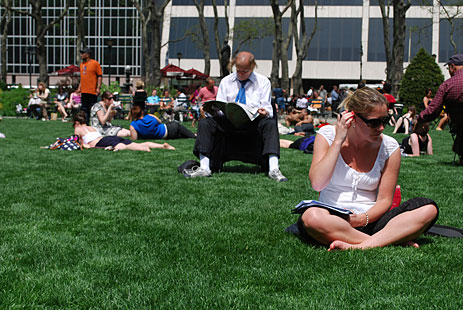 Heat wave in Bryant Park, N.Y.C.Photo courtesy wolfsavard via FlickrHere in Philly, where the dog days of summer started early, we’re just on the other side of a pair of record-setting days — two days of highs over 100 degrees F. “We’re getting a dramatic taste of the kind of weather we are on course to bequeath to our children and grandchildren,” Tom Peterson, NOAA’s chief scientist observed the other day.
Heat wave in Bryant Park, N.Y.C.Photo courtesy wolfsavard via FlickrHere in Philly, where the dog days of summer started early, we’re just on the other side of a pair of record-setting days — two days of highs over 100 degrees F. “We’re getting a dramatic taste of the kind of weather we are on course to bequeath to our children and grandchildren,” Tom Peterson, NOAA’s chief scientist observed the other day.
But a just-released report from Stanford University (via Science Daily) suggests that what we’re getting is a preview of our own near-future climate. As in next decade. As lead scientist Noah Diffenbaugh put it:
In the next 30 years, we could see an increase in heat waves like the one now occurring in the eastern United States or the kind that swept across Europe in 2003 that caused tens of thousands of fatalities … Those kinds of severe heat events also put enormous stress on major crops like corn, soybean, cotton, and wine grapes, causing a significant reduction in yields.
To determine this, Diffenbaugh and his team spent two years working with a “high-resolution” climate model that can estimate temperatures in small areas. Most climate models look at large-scale temperature trends rather than temperature predictions across the “local” level. This new model can generate temperature estimates city-by-city throughout the country.
The researchers pulled historical record highs and heat waves from the period 1951-1999, and then looked to see how often those “records” might be met or exceeded in future years. The big surprise was that the model anticipates significant changes starting … well, now.
Temperatures equaling the hottest season on record from 1951 to 1999 could occur four times between now and 2019 over much of the U.S., according to the researchers.
The 2020s and 2030s could be even hotter, particularly in the American West. From 2030 to 2039, most areas of Utah, Colorado, Arizona, and New Mexico could endure at least seven seasons equally as intense as the hottest season ever recorded between 1951 and 1999, the researchers concluded.
“Frankly, I was expecting that we’d see large temperature increases later this century with higher greenhouse gas levels and global warming,” Diffenbaugh said. “I did not expect to see anything this large within the next three decades. This was definitely a surprise.”
By the 2030s, these researchers expect “persistent, drier” conditions across the U.S., similar to what you see during droughts. As a result, greenhouse effects will be amplified.
From extreme winters to extreme summers, climate change is gearing up to be quite the roller-coaster ride. Perhaps nationwide Dust Bowl conditions in 2030 will be enough to get us to finally put a price on carbon. Or we could, you know, do it now.


